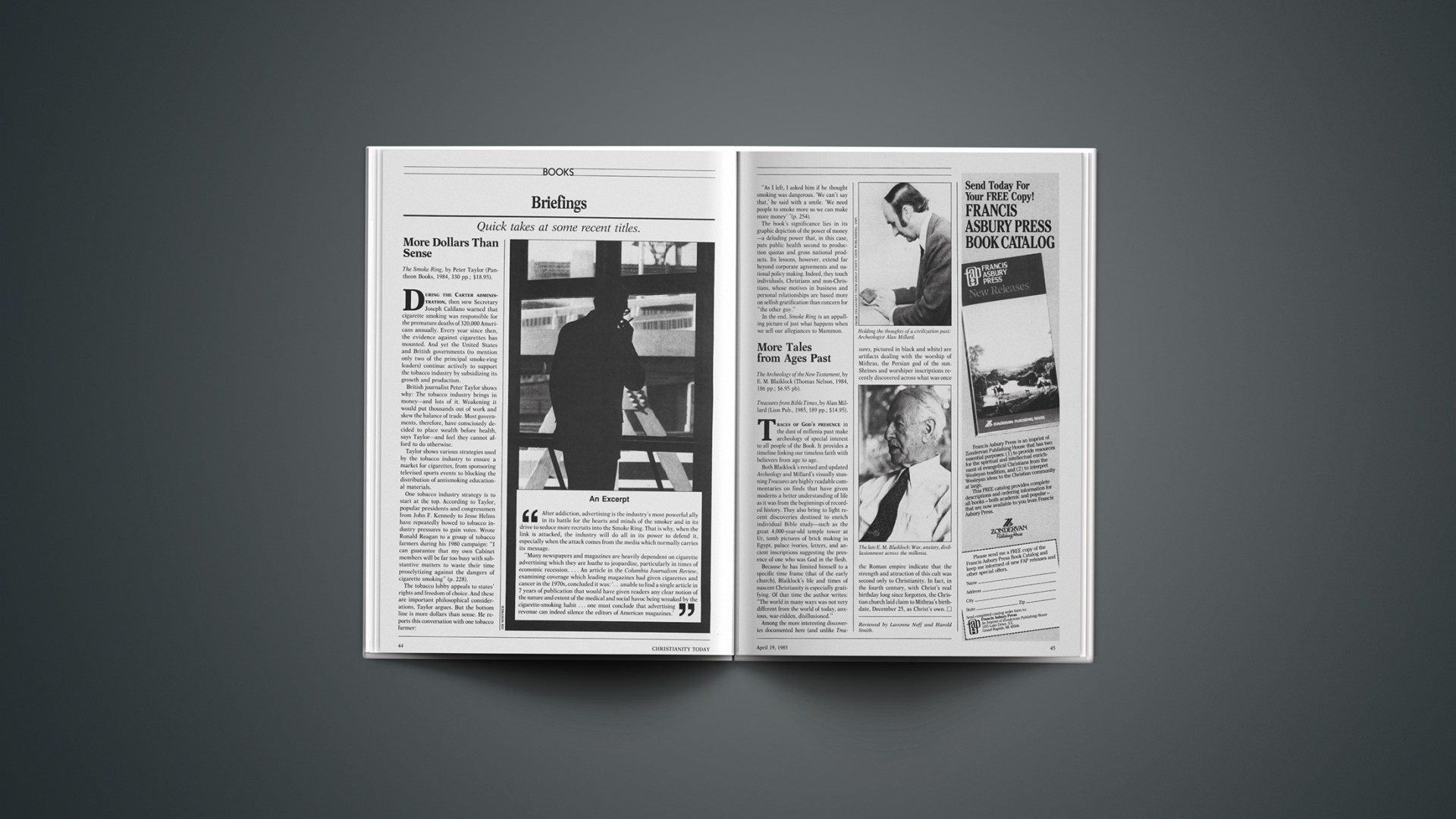Quick takes at some recent titles.
More Dollars Than Sense
The Smoke Ring, by Peter Taylor (Pantheon Books, 1984, 330 pp.; $18.95).
During the Carter administration, then HEW Secretary Joseph Califano warned that cigarette smoking was responsible for the premature deaths of 320,000 Americans annually. Every year since then, the evidence against cigarettes has mounted. And yet the United States and British governments (to mention only two of the principal smoke-ring leaders) continue actively to support the tobacco industry by subsidizing its growth and production.
British journalist Peter Taylor shows why: The tobacco industry brings in money—and lots of it. Weakening it would put thousands out of work and skew the balance of trade. Most governments, therefore, have consciously decided to place wealth before health, says Taylor—and feel they cannot afford to do otherwise.
Taylor shows various strategies used by the tobacco industry to ensure a market for cigarettes, from sponsoring televised sports events to blocking the distribution of antismoking educational materials.
One tobacco industry strategy is to start at the top. According to Taylor, popular presidents and congressmen from John F. Kennedy to Jesse Helms have repeatedly bowed to tobacco industry pressures to gain votes. Wrote Ronald Reagan to a group of tobacco farmers during his 1980 campaign: “I can guarantee that my own Cabinet members will be far too busy with substantive matters to waste their time proselytizing against the dangers of cigarette smoking” (p. 228).
The tobacco lobby appeals to states’ rights and freedom of choice. And these are important philosophical considerations, Taylor argues. But the bottom line is more dollars than sense. He reports this conversation with one tobacco farmer:
An Excerpt
“After addiction, advertising is the industry’s most powerful ally in its battle for the hearts and minds of the smoker and in its drive to seduce more recruits into the Smoke Ring. That is why, when the link is attacked, the industry will do all in its power to defend it, especially when the aattack comes from the media which normally carries its message.
“Many newspapers and magazines are heavily dependent on cigarette advertising which they are loathe to jeopardize, particularly in times of economic recession.… An article in the Columbia Journalism Review, examining coverage which leading magazines had given cigarettes and cancer in the 1970s, concluded it was: ‘… unable to find a single article in 7 years of publication that would have given readers any clear notion of the nature and extent of the medical and social havoc being wreaked by the cigarette-smoking habit … one must conclude that advertising revenue can indeed silence the editors of American magazines.’ ”
“As I left, I asked him if he thought smoking was dangerous. ‘We can’t say that,’ he said with a smile. ‘We need people to smoke more so we can make more money’ ” (p. 254).
The book’s significance lies in its graphic depiction of the power of money—a deluding power that, in this case, puts public health second to production quotas and gross national products. Its lessons, however, extend far beyond corporate agreements and national policy making. Indeed, they touch individuals, Christians and non-Christians, whose motives in business and personal relationships are based more on selfish gratification than concern for “the other guy.”
In the end, Smoke Ring is an appalling picture of just what happens when we sell our allegiances to Mammon.
More Tales From Ages Past
The Archeology of the New Testament, by E. M. Blaiklock (Thomas Nelson, 1984, 186 pp.; $6.95 pb).
Treasures from Bible Times, by Alan Millard (Lion Pub., 1985, 189 pp.; $14.95).
Traces of God’s presence in the dust of millenia past make archeology of special interest to all people of the Book. It provides a timeline linking our timeless faith with believers from age to age.
Both Blaiklock’s revised and updated Archeology and Millard’s visually stunning Treasures are highly readable commentaries on finds that have given moderns a better understanding of life as it was from the beginnings of recorded history. They also bring to light recent discoveries destined to enrich individual Bible study—such as the great 4,000-year-old temple tower at Ur, tomb pictures of brick making in Egypt, palace ivories, letters, and ancient inscriptions suggesting the presence of one who was God in the flesh.
Because he has limited himself to a specific time frame (that of the early church), Blaiklock’s life and times of nascent Christianity is especially gratifying. Of that time the author writes: “The world in many ways was not very different from the world of today, anxious, war-ridden, disillusioned.”
Among the more interesting discoveries documented here (and unlike Treasures, pictured in black and white) are artifacts dealing with the worship of Mithras, the Persian god of the sun. Shrines and worshiper inscriptions recently discovered across what was once the Roman empire indicate that the strength and attraction of this cult was second only to Christianity. In fact, in the fourth century, with Christ’s real birthday long since forgotten, the Christian church laid claim to Mithras’s birth-date, December 25, as Christ’s own.
Reviewed by Lavonne Neff and Harold Smith.










